On March 25th of this year, Major League Soccer announced Minnesota United as an expansion team and the league’s 23rd franchise. While the event was a spectacle – some called it the best attended and celebrated franchise announcement in league history – momentum was quickly lost. Minnesota United owner Dr. Bill McGuire and his MLS partners had picked an isolated and industrial site for their stadium near the North Loop and the Warehouse District which was soon called the West Loop. Minneapolis Mayor Betsy Hodges was conspicuously absent from the MLS event held in her own city and was quick to go public with her concerns for granting tax exemptions or infrastructure improvements to the Royalston site. Hodges even stated she thought the stadium would create competition with Target Center (home of the Timberwolves) which the city is currently renovating. She questioned why the Loons couldn’t play on the artificial turf and narrow width of TCF Bank Stadium or the US Bank Stadium currently being constructed. While claiming she was a soccer fan, she revealed her lack of knowledge of the sport. MLS chose Minnesota United over the Vikings because of an open air, soccer specific stadium with real grass.
At the same time the state legislature puffed its chest and called for no breaks for Minnesota United. Most legislators didn’t know McGuire and his ownership group were going to foot the entire bill for the stadium to the tune of approximately $120 million plus land cost and franchise fees. The legislative posturing was clearly bravado for constituents. A bill never passed. Things got quiet until McGuire reached out to St. Paul. His idea was to possibly locate the stadium at the abandoned Midway area bus barn site at I-94 and Snelling Avenue, one block south of University Avenue. It was a location he had identified shortly after purchasing the team in 2013.
When asked about the idea of a MLS stadium at the bus barn location, St. Paul Mayor Chris Coleman presented a juxtaposition from his counterpart on the west side of the Mississippi. Disclosed emails quote the St. Paul mayor as writing, “Hell yeah!”
Since that time things have been moving rapidly in Minneapolis’ sister city of St. Paul. Coleman met with MLS’s deputy commissioner and president Mark Abbott, touring him around the city. He met with Minnesota United again last week to talk about next steps.
Several weeks ago in a press conference, Coleman indicated he would support eliminating property taxes for Minnesota United if they built a stadium on the bus barn site owned by the Met Council which has been off the tax roles for fifty years. He called the stadium a catalyst for redevelopment of the Midway Center site as well as the entire city of St. Paul.
Last Thursday the St. Paul city council’s agenda was made public and showed a resolution that will be presented on Wednesday, August 26th, by Councilmen Dai Thao and Chris Tolbert. It supports property tax exemption for an MLS stadium as long as it’s privately funded. Political insiders are saying the resolution will have wide support by the council.
So what about this Midway bus barn location? Why did Dr. McGuire and team President Nick Rogers feel this site was good? What are some of the reasons it will work for an MLS stadium and what will it take to make it successful?
History
First, lets look at the history of Midway and the Snelling University area. Midway received its name by being located halfway between the downtown’s of St. Paul and Minneapolis. It is a central location between both city centers and suburbs north and south, east and west.
As this YouTube video explains, University Avenue has long been a center for transportation and commerce. If a stadium is built on the site with the Metro Transit Green Line a primary mode of transportation to and from the venue (more on that later) it wouldn’t be the first time rail line cars accommodated riders for special events in the Midway.
History of University Avenue
For many years the Prom Ballroom, located on University a block west of Lexington, was the place to be for entertainment. In the 1940’s and 50’s, bands of national and international renown came to play and drew large enough crowds to require extra street cars to transport attendees to and from events.
Just a block east and south of the Prom was the St. Paul Saints old stadium called Lexington Park. The team would sometimes play “street car doubleheaders” with the Minneapolis Millers. After the St. Paul leg, loads of fans would hop
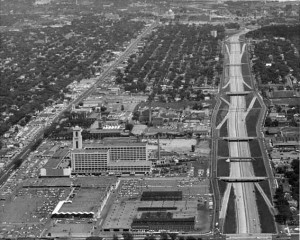
on the street car and head down University Ave to Minneapolis to catch the second game at the Millers Nicollet Park.
Just south of Lexington Park is James Griffin Stadium, the home of St. Paul Central High School and where the Minnesota Thunder professional soccer team played their games from 2004 until 2008. The team moved to the narrow high school stadium because fan surveys showed they wanted a more central location than Blaine and the NSC Stadium.
Renaissance
University Avenue is experiencing a renaissance with the hugely successful Green Line LRT that has surpassed expectations for ridership. From the West Gate area near highway 280 up to Snelling, new and renovated high density housing structures line the avenue. New businesses like the Habitat for Humanity Building at Prior and additions to Episcopal Church Homes senior complex next to Iris Park are enhancing the corridor.
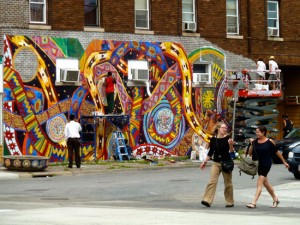
East of Snelling there are new dwelling spaces being built. Further to the east of Dale and just a quick LRT trip from the stadium site, is Little Mekong. Southeast Asian businesses now dot University with some of the best Asian cuisine in the Twin Cities.
A block to the north of University on Snelling is the Little Africa area with more excellent and authentic cuisine. The new Midway Murals project is a testament to efforts to revitalize this area of Snelling.
Just a half mile to the south of University between Selby and Marshall the impeccably renovated Legacy Rose building has become a destination with its many boutique shops. Kitty corner is O’Gara’s and the Neighborhood Cafe. Across Selby, Ryan companies has built a new Associated Bank building and is currently constructing a new 200 unit mixed use apartment building designed for young professionals with Whole Foods as the anchor tenant.
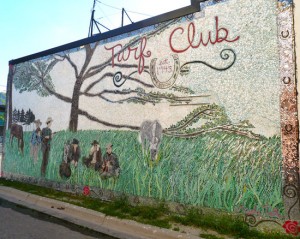
Around the intersection of University and Snelling you will find much diversity in businesses such as the limestone building that houses Midway Bookstore and just to the west the legendary Ax Man Surplus. The Turf Club is just a block walk from the potential bus barn site and there are five more bars on the north side of University between Snelling and Lexington.
This summer Snelling Ave. has been getting a facelift that will continue through the spring of 2016. MnDOT built a new bridge deck over I-94 and is repaving Snelling from Marshall Ave. to Pierce Butler. Old fashioned St. Paul streetlamp’s are being installed all along the corridor with all new sidewalks that are ADA compliant as well as many new trees and plantings.
Public and Alternative Transportation
While work is being done to improve the infrastructure of Snelling Avenue, Metro Transit is also installing new Bus Rapid Transit (BRT) stations. The A–Line BRT is the first arterial BRT in the Twin Cities. It will run from the Blue Line LRT at Hiawatha and 46th Street in Minneapolis, across the Highland Bridge, up Ford Parkway (also getting a makeover this summer) and turns on Snelling to hook up with the Green Line at University. It continues on and will travel all the way to Rosedale Shopping Center. The BRT operates much like the LRT with kiosk stations to buy fares before one enters the bus. Front and rear doors will be accessible for entry and exit. The line will run every 10 minutes, have digital signage like the LRT and stop right in the lane with bump-outs for quick arrivals and departures from each station.
The BRT and the LRT are both important reasons why a St. Paul Midway stadium will be successful. During a recent three game weekend series between the Twins and the NY Yankees, Metro Transit’s LRT routes delivered one in three fans (33%) to the game.
Metro Transit declined requests to estimate how many people they thought could be moved to and from a Minnesota United match at the Midway site using LRT, BRT and traditional buses. They directed me to a page on their website that states an estimated 24 percent of fans or 13,000 people, took LRT to each of the Vikings’ regular season home games in 2014. Those numbers are very good considering Vikings fans are older and more affluent than soccer fans with many of them coming from the west and southwest suburbs.
Metro Transit time laps video of fans leaving the Vikings game at Stadium Village via the LRT
With news of the Twins strong ridership numbers as well as Metro Transit’s announcement that the Green Line surpassed the Blue Line in ridership in its first year, I checked on cities that have popular stadiums in urban locations. Two teams immediately came to mind: The Cubs (Wrigley Field) and the Portland Timbers (Providence Park)
At the top of the Cubs webpage addressing parking it states, “Cubs fans are strongly encouraged to use public transportation going to and from Cubs games.”
Much of the page is devoted to explaining to fans how to get to the stadium without driving. There are options if you choose to drive and park nearby, and you can expect to pay a lot of money.
In Portland, those familiar with the team say they were very proactive with communication about public transportation in the first two years after stadium renovations when the team moved to MLS. Parking is limited in the area of Providence Park so encouraging alternative transportation was important. These days fans seem to easily find their way to the stadium without driving.
Chris Metz, VP of Communications for the Portland Timbers said a recent survey found 62% of those attending Timbers games now take public transportation.

The Timbers offer up 250 portable bike racks which are constantly at capacity. Most of the bike parking is for season ticket holders and is currently sold out. A limited amount of bike parking is available for non-season ticket holders. Metz says many more people bike to games and find other places to park and lock up.
Unlike the Midway site, Providence Park is downtown. However, their LRT does pass by the stadium much like the Green Line will be accessible with only a block walk from the bus barn location. The demographics of Portland fans is also similar to what can be expected in the Twin Cities with United fans. Portland has a good public transit system and biking is popular. It’s not unreasonable to believe that with the younger more urban demographic of both MLS and Minnesota United fans, a 60-75% mass transit ridership could be obtainable by 2018. With the large Ramsey County immigrant population – especially those living in close proximity to the stadium – those numbers could exceed Portland’s numbers.
Conservatively looking at Minnesota United’s numbers with 50% arriving by alternative transportation and with a stadium capacity of 18,500 there would be 9,250 fans arriving by vehicle.
Parking
There’s no doubt that some additional parking would be needed for an MLS stadium at the bus barn site. But how much parking? Perhaps not as much as you think.
After careful research of the area by walking, driving and using tools like Google Earth, there appear to be almost 4,000 underutilized parking spots within one half mile in each direction of the University and Snelling interchange. All of these spots are entirely empty on weekends and mostly empty on weekdays after 5:30 p.m. Using a conservative ratio of 2.5 fans per car (most teams use 3:1), there is enough parking for 10,000 fans. This number excludes any street parking or any potential park and ride options using the State Fairgrounds.
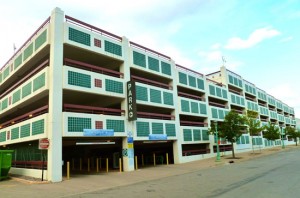
An example of the underutilized parking is the Spruce Tree ramp across Snelling Ave. from the potential stadium site. The city owned lot currently has 353 parking spots and Mayor Coleman’s office says the ramp is expandable to 600 spots.
A block west of Spruce Tree ramp is Health East Specialty Center, the site of the old Midway Hospital. Years ago Health East controversially purchased several houses to tear down and use for additional surface parking. The lot currently has 436 parking spots and sits empty on weekends. The site also has a ramp with 233 spaces. This scenario is repeated up and down University Avenue one-half mile in either direction from Fairview to Lexington.
Convincing some of those businesses to open up their lots for parking may take some work, but shared parking is a good use of valuable real estate designated only for cars. It would also be wise for the city and Minnesota United to jump on board with mobile application like ParkMe to help guide motorists efficiently to nearby parking.
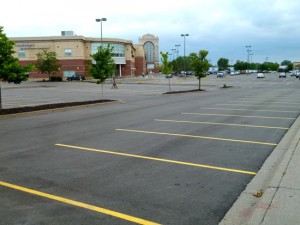
Just a seven minute LRT ride to the west is West Gate Station. The location is at Highway 280 and University which has approximately 1000 more parking spots in the general area. The site would make an ideal park and ride for those going to United matches and make a much more efficient commute. Beyond that there are thousands of more parking spots a little further to the west in lots along University in Minneapolis that people are already using to go to Twins, Vikings and Gophers games. Those lots are an approximate 10 minute LRT ride from the Snelling Avenue Station.
Another ramp on the redevelopment site will still most likely be needed but could serve both Minnesota United and the businesses that will be part of a redevelopment of the Midway Center strip mall. St. Paul City Council President Russ Stark presented a similar thought in his letter to his constituents. It was also registered as a hope of neighboring citizens at the Union Park District Council (UPDC) meeting several weeks ago. A shared ramp would also help to overcome a $30 million gap between land values of the shopping center, cost of demolition, new redevelopment construction, and infrastructure that was outlined last year in an independent study paid for by the Met Council, the city and RK Midway.
Traffic
The Snelling at I-94 interchange has some obstacles that would need to be overcome to get cars in and out of the area efficiently. Snelling already carries almost 50,000 cars daily over the I-94 bridge. The intersections at St. Anthony and Snelling and Concordia at Snelling (the I-94 bridge separates the two corners) are two of the most dangerous in the state of Minnesota. New design features at those corners in traffic flow and signalization were part of the makeover this summer and should help to reduce accidents.
Approximately 150,000 cars pass by this location daily on I-94. Stadium naming rights will be attractive as the venue name will be visible to all those cars on a daily basis. As long as games are in the evenings or on weekends the area should be able to handle the traffic with some adjustments to infrastructure. Traffic was one of the main concerns of neighbors at the UPDC meeting.
St. Paul is a College Town
Another key feature of the Midway bus barn site is the proximity to four colleges in St. Paul within 1.5 miles of the site. Concordia College (.4 miles), Hamline University (.75 miles), Macalester College (.75 miles) and St. Thomas University (1.4 miles) have a total of 13,000 undergraduates enrolled. The University of Minnesota built around University Avenue is just a 10 minute LRT ride to the Snelling Avenue Station. It has 30,000 undergraduates attending. That makes a total of 43,000 potential Minnesota United supporters. Catering to this MLS target market aged group will be a key to the success of filling the stadium and having a vibrant audience that understands and appreciates the sport.
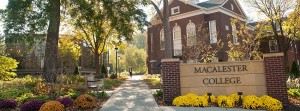
Immigrant Community
Ramsey County has a much larger immigrant community than Hennepin County. Many of those communities actually reside in St. Paul proper and live close by to the bus barn site. A concern and hope of neighbors was that affordable tickets and some free tickets be made available to those in the area with financial need, particularly since soccer is an international game and the sport that many of these community members know and love. In order to get buy in from those communities in St. Paul, the prices will need to be affordable. These young adults are just a few years from being the target market of Minnesota United’s future.
There was also a desire by many at the UPDC meeting that the stadium be made available for many soccer events within the community. While this may not be possible with the cost and importance of a pristine real grass surface for professionals, McGuire has in the past spoke of making the stadium available for events like the Minnesota State High School League Tournament finals, Minnesota Intercollegiate Athletic Conference finals and Minnesota Youth Soccer State finals. Allowing youth and ethnic communities access may be difficult but could be accomplished by building an exhibition/practice field next to the stadium or possible partnering with the Lexington Hamline Community Council, Union Park District Council, Sanneh Foundation, St. Paul Parks and the Trust for Public Land who are working on obtaining property next to Skyline Towers run by Common Bond. It’s the hope of these organizations to obtain land for both small sided and large soccer fields for these communities. A Minnesota United field with branding located next to Skyline Towers would go a long way toward including the Somali, Oromo, Vietnamese, Hmong, Karen and Hispanic communities living in the area.
Midway Center Redevelopment
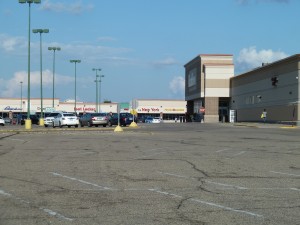
There is no doubt that the redevelopment of the run down Midway Center shopping mall with all its surface parking and no vertical density is key to both city and community approval. The shopping center is still a profitable and valued asset by the community. The original Transit Oriented Development (TOD) plan for the shopping center and bus barn site was created by the Met Council, the City of St. Paul Planning, representatives for RK Midway and St. Paul Riverfront Corp (urban planners) to use as a starting point. It recommends the current retail space be combined with mixed use development including housing with street grids and green space.
The Southeast corner of University and Snelling is clearly the most valuable land on the site. In fact the owners of the property, RK Midway, based out of NY and it’s owner Rick Birdoff, have stated as much in local UPDC Land Use Committee meetings and have hopes of building an eight story high density housing property at that location as part of a transit oriented development. To date there has been no catalyst to make this development happen.
This spring, RK Midway subdivided property along the most western edge of their site in order to refinance it and start to build a north/south street per the TOD concept. They also had plans for a temporary use of the empty bank building at Snelling and University and planned to build another building next to the bank as a coffee shop. After the gap in cost to profitability was revealed, RK Midway’s interest dropped.
A recent letter from councilman Chris Tolbert’s legislative aid Libby Kantner might be a clue to concepts that are currently being bounced around for redevelopment of the site. Beside a street grid and park that councilman Stark mentioned in his letter, Tolbert’s aid recently stated in a letter to a St. Paul constituent, “we would likely see an expansion in the tax base when the neighborhood around the site is given a privately-funded facelift to greet, feed, sell to and house MLS fans.” The sentence seems to sum up potential plans for the site: Greet (green space), feed (restaurants and bars), sell to and house (mixed use retail and housing and perhaps even the concept of a hotel.) These are all ideas that have previously been discussed in the realm of TOD for the site. They were also ideas presented by neighbors at the recent UPDC community meeting.
While all these ideas were excellent, they were still just ideas. With the catalyst of an MLS stadium being built on the 10 acre bus barn site, everything now seems to be back on the table and the chances of a TOD plan coming to fruition are greatly enhanced.
Adam Jarvi contributed to the this article.
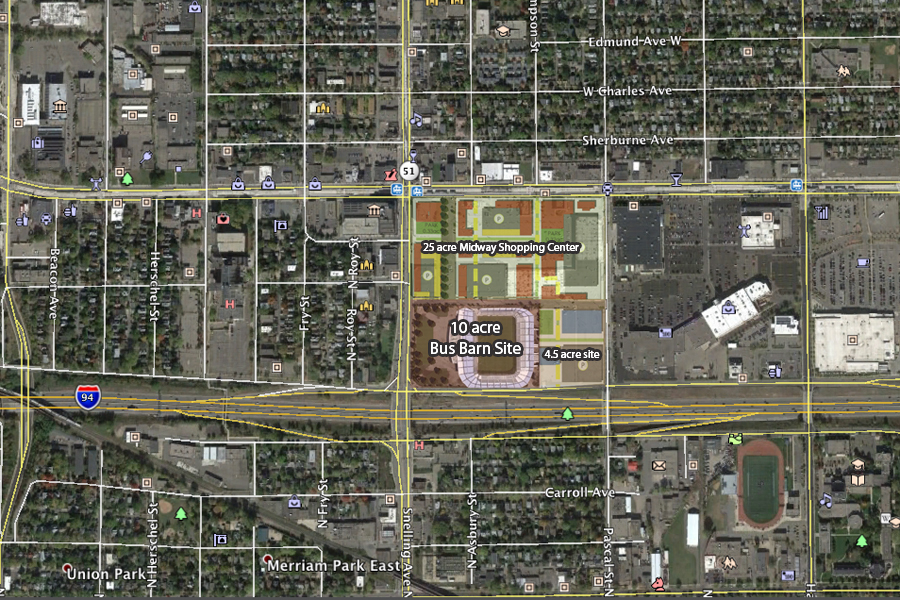
Leave a Reply